GS Paper III
News Excerpt:
The World Meteorological Organization’s ‘State of the Climate in Asia 2023’ report notes that Asia has warmed faster than the global average, and the warming trend has nearly doubled since the 1961-1990 period.
Key data in the report:
- In 2023, there were 79 events associated with hydrometeorological hazards, affecting more than nine million people and directly killing over 2,000 across Asia.
- Over 80 per cent of the reported hydrometeorological hazards in Asia were flood and storm events.
- Over 60 per cent of the 2,000 deaths due to disasters were associated with flooding, and over 15 per cent with storms.
- Only two disaster events were reported in the region in 2023 compared to 2022.
- However, the number of people impacted in 2023 was lower, as the 2022 Pakistan floods alone affected over 30 million people.
- In India, the impacts of extreme weather events were felt strongly as the country experienced severe heatwaves, rainfall-induced floods, glacial lake outbursts, and tropical cyclones.
- The report emphasised that the accelerating rate of key climate change indicators such as surface temperatures, glacier retreat, and sea level rise will have major consequences for Asia, its economy, and its ecosystems.
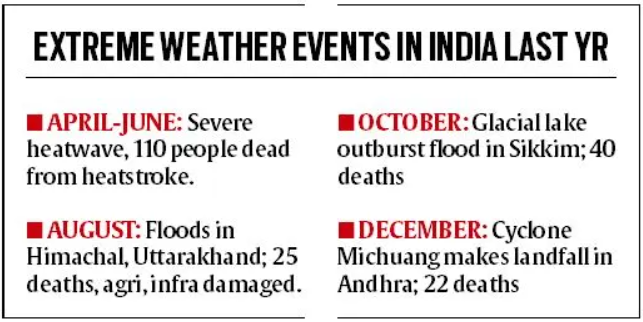
- The report noted that severe heat waves in April and June 2023 resulted in about 110 deaths from heatstroke.
- Last year, the Ballia and Deoria districts in Uttar Pradesh saw the deaths of over 100 people, many of them senior citizens with co-morbidities.
- Temperatures were in the 42-43 degrees Celsius range in the region during these heat-related deaths.
- Last year, a prolonged heatwave also affected much of Southeast Asia, extending westwards into Bangladesh, eastern India, and parts of China.
- Flood events occurred in India during August 2023, and Himachal Pradesh and Uttarakhand recorded 25 deaths and extensive damage to infrastructure and agriculture.
- Triggered by heavy rainfall, the disaster compounded the effects of an earlier monsoon surge in June.
- The Indian government declared a state of emergency in the worst-affected areas, initiating rescue and relief operations.
- The Indian sub-continent experienced six tropical cyclones in 2023, which formed in the North Indian Ocean.
- The cyclone activity was slightly above the average of 5.4 cyclones.
- Four of the six cyclones—Mocha, Hamoon, Midhili, and Michaung—formed over the Bay of Bengal, and two—Biparjoy and Tej—formed over the Arabian Sea.
- The extremely severe cyclonic storm Mocha made landfall along the Rakhine Coast in Myanmar and killed 156 people.
- In India, Michaung made landfall in south Andhra Pradesh and claimed 22 lives.
- The report also noted the significant “glacial lake outburst flood” that occurred in South Lhonak Lake in Sikkim last year.
- The incident had overtopped and breached the Chungthang dam downstream on the Teesta River and killed over 40 people, according to the Sikkim government.
- This type of disaster is increasingly observed because of climate change-induced glacier retreat and highlights the compounding and cascading risks faced by vulnerable mountain communities.
Chart 1 below gives an overview of such events that took place in Asia last year and their impact.
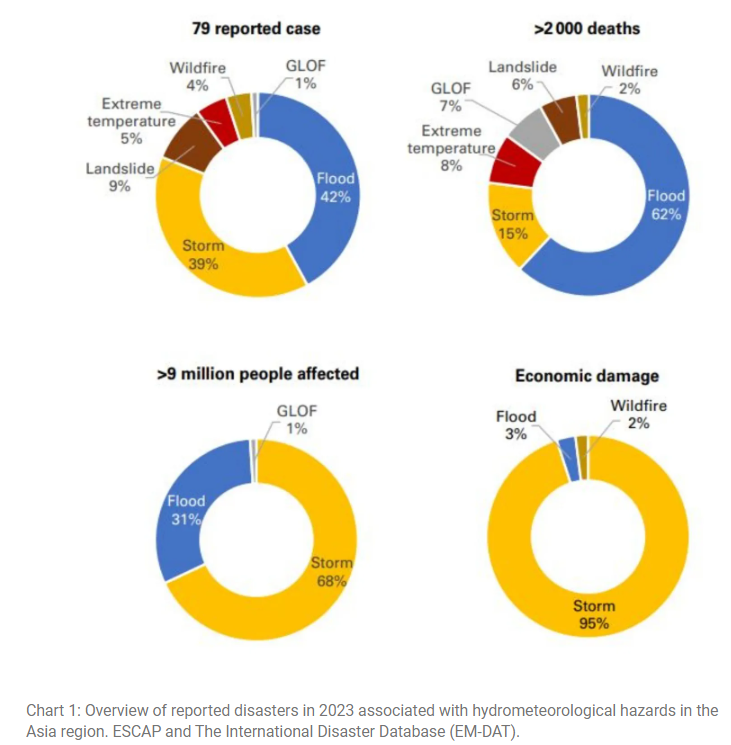
Four other charts that give a more comprehensive picture of the climate crisis unfolding in Asia.
- Temperature:
- In 2023, the average annual surface temperature was 1.87 degrees Celsius above the 1961–1990 average and 0.91 degrees Celsius above the 1991–2020 average.
- The world has become at least 1.1 degrees Celsius warmer than the pre-industrial average (1850-1900).
- According to the report, Asia and the world have different reference periods for calculating the temperature difference because the former has insufficient data prior to the 1900s.
- More worryingly, the rate of warming in Asia is accelerating.
- See chart 2, which compares Asia with five other regions: Africa, South America, North America, South-West Pacific, and Europe.
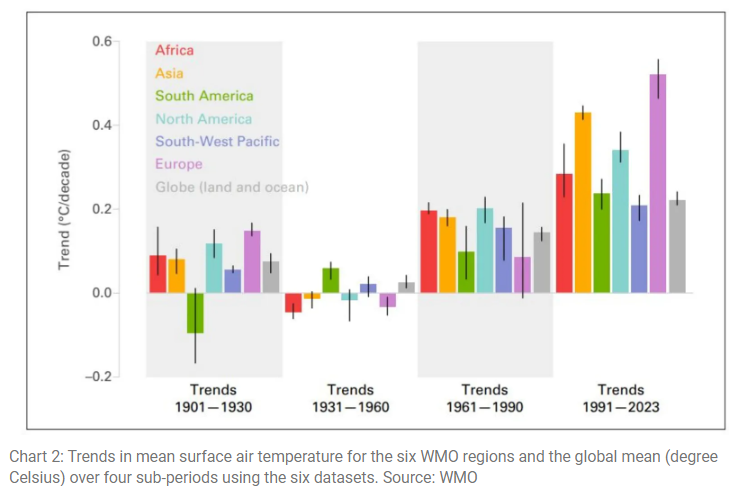
-
- Asia has gotten more warm in recent decades than other regions except Europe.
- The warming trend in Asia from 1991 to 2023 was almost double that during the 1961–1990 period and much larger than the trends of the previous 30-year periods.
- Glaciers:
- In the glaciological year 2022-23, 20 out of 22 observed glaciers in the High Mountain Asia (HMA) region — a high-elevation area centred on the Tibetan Plateau, which contains the largest volume of ice outside of the polar regions — showed continued mass loss.
- This happened primarily due to record-breaking high temperatures and dry conditions in the East Himalayas.
- Chart 3 shows the mass balance—the amount of mass gained or lost by the glacier expressed in metres of water equivalent (m w.e.)—of four such glaciers in the HMA region.
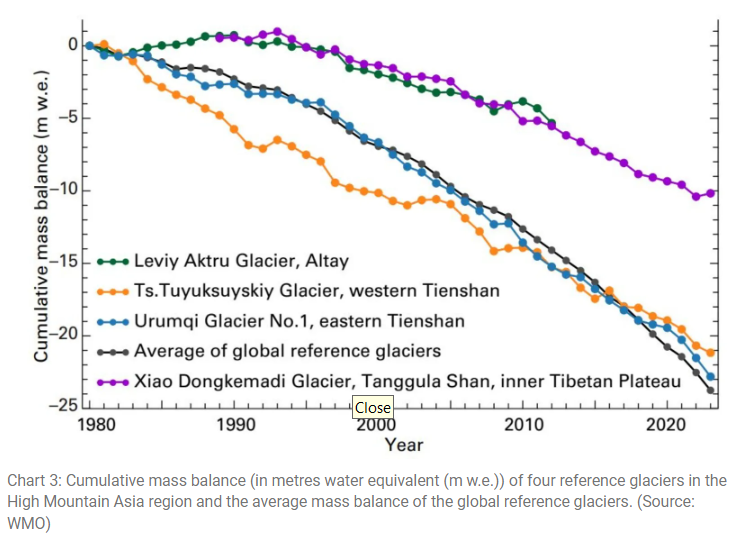
-
- These glaciers have recorded significant mass losses in the past 40 years, with an increase in the rate of mass loss since the mid-1990s.
- Precipitation
- In 2023, rainfall was below normal in large parts of countries like Turkmenistan, Pakistan, and Myanmar.
- In India, the summer monsoon season rainfall averaged over India from June to September last year was about 6% below the 1971–2000 average.
- For the second consecutive year, certain regions in southwest India, such as the Ganges catchment and the lower course of the Brahmaputra, received less-than-normal precipitation.
- Excess rainfall was observed around the lower course of the Indus River (Pakistan), the Tenasserim Range (Myanmar), in Kamchatka and the Kolyma Range (Russian Federation).
- Chart 4 shows which areas received more or less rainfall in 2023 in comparison to the 1991–2020 reference period.
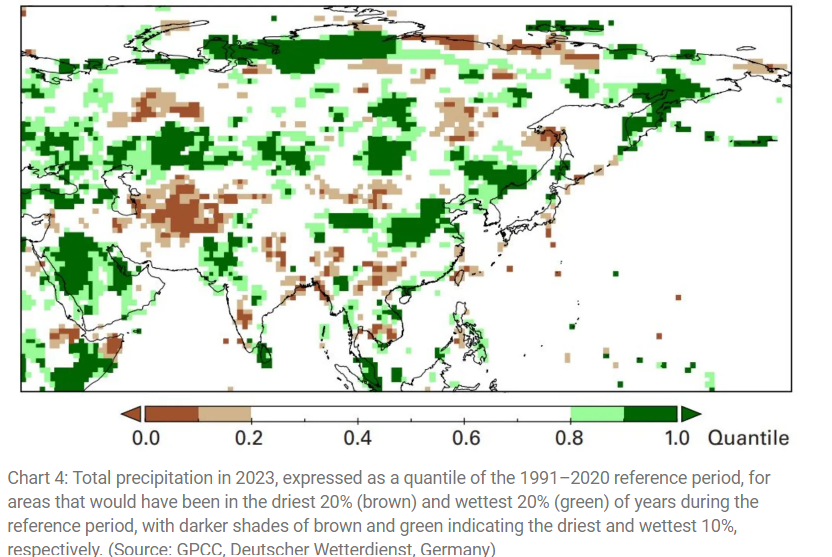
- Sea surface temperature (SST):
- The global average sea surface temperature (SST) has been off the charts since mid-March 2023.
- Ocean temperatures in Asia have been no different. Last year, the worst affected was the North-west Pacific Ocean, where the area-averaged sea surface temperature anomalies were the warmest on record, according to the WMO report. (See chart 5)
- Moreover, warming of the upper ocean (0 m–700 m) is particularly strong in the North-Western Arabian Sea, the Philippine Sea, and the seas east of Japan, more than three times faster than the global average.
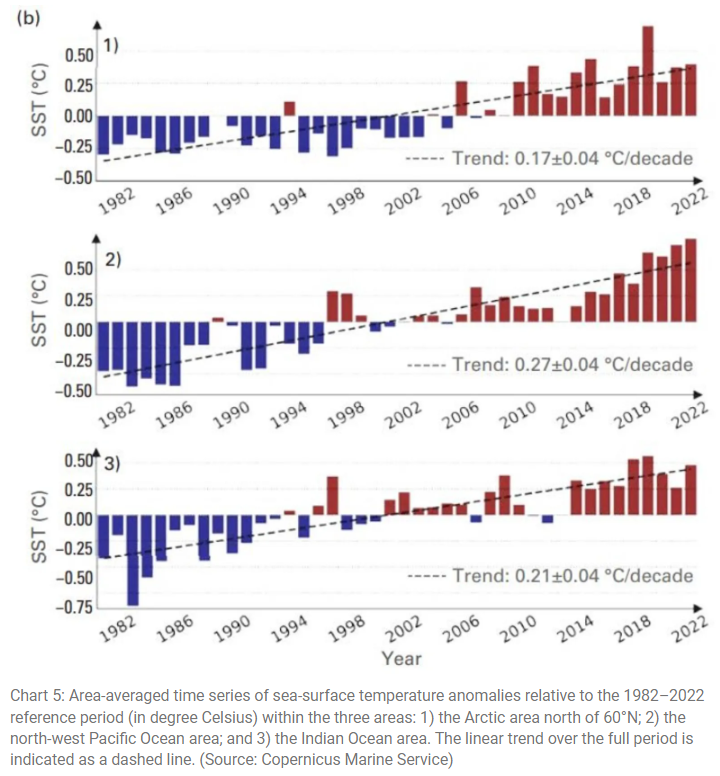
Conclusion:
Overall, the report underscores the urgent need for concerted efforts to mitigate the impacts of climate change and strengthen resilience to extreme weather events in Asia.


